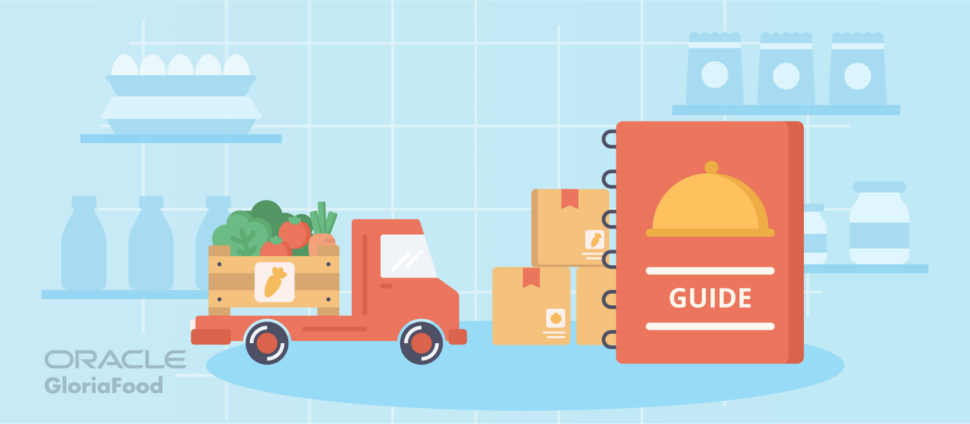- 1.What Is Supply Chain Management?
- 2.Why food supply chain management is important
- 3.Efficient Restaurant Supply Chain Management: 17 Tips to Follow
- Consider demand
- Maintain a warm relationship with your suppliers
- Pay attention to cheaper items
- Manage your inventory
- Manage recipes
- Control the amount of waste
- Eliminate one-time purchases
- Delegate and educate
- Quality control
- Be eco-friendly
- Use a closed-loop economy
- Re-evaluate your relationship with your suppliers
- Track your shipments
- Keep in touch with your drivers
- Control promotions
- Fill out reports and conduct analytics
- Use technology
- 4.Bottom Line
Successful restaurateurs are those professionals who fully understand every process involved in running a food business, including effective supply and demand management.
In this article, you’ll learn what rules to follow to get your restaurant business up and running. Even if you’re a novice in the field, our restaurant supply chain management tips will help you stay on track and provide quality service.
What Is Supply Chain Management?
Supply chain management (SCM) is a clear and organized system of processes that controls a business’ flow of goods, services, data, and finances. In fact, this system covers all restaurant functions, from purchasing to customer satisfaction.
The following activities can be related to supply chains:
- Sourcing raw materials (food suppliers and other vendors, e.g., paper utensils);
- Logistics (people who deliver raw materials to the indicated address of your restaurant);
- Production (the stage when raw materials are turned into a product, i.e., food preparation);
- Inventory management (monitoring consumption of food/materials and procurement of missing raw materials).
You can create your own supply chain diagram in a few minutes with the help of online editable templates. However, it will be much easier when you know how to manage scheduling, planning, and quality.
Why food supply chain management is important
Any problems with your supply chain can lead to significant shortages in your kitchen that will ultimately affect your clients. Here are the benefits you will enjoy if you do effective restaurant supply chain management:
- More efficient processes: your kitchen will run smoothly because you will have accurate orders fulfillment, timely delivery of good and efficient communication with suppliers and distributors;
- Manage costs: food costs are the biggest issue for all restaurant owners. With restaurant supply chain management, you ensure you have optimized inventory levels and reduced waste;
- Consistency: the best restaurants are the ones who manage to deliver the same quality for every served dish. By having a constant flow of needed ingredients, you are always prepared to offer outstanding menu items;
- Helps you engineer your menu: if you know how supply dynamic work, you can take advantage of seasonality and market trends to create a profitable menu that will attract clients;
- Increased customer satisfaction: imagine this situation. A client looked over your menu before they made a reservation and chose what they want to eat. When they get to your place, you let them know the menu item they want is no longer available. Efficient restaurant supply chain management can easily prevent disappointing your clients.
Read more: 4 Menu Engineering Design Tips & Secrets That Will Boost Your Sales
Efficient Restaurant Supply Chain Management: 17 Tips to Follow
It is never too late to start implementing restaurant supply chain solutions. Try out these tips if you want to enjoy the benefits listed above in no time:
1. Consider demand
You’re working with customers, and they’re the ones who set the rhythm for what suppliers to look for. Therefore, the entire supply chain cycle begins with the following processes:
- Studying. Look at your last year’s analytics and find out the most popular dishes for a certain period;
- Forecasting. Consider last year’s performance and find out what triggered the decrease/increase in sales;
- Identifying trends. If you can’t study the previous year’s numbers, look at the last few weeks;
- Considering external factors. For example, weather/seasonality can cause a decrease or increase in demand.
Read more: How to Capitalize on Restaurant Seasonality to Increase Profits
2. Maintain a warm relationship with your suppliers
For your restaurant to perform correctly, you must find dependable suppliers and build a trusting relationship with them. There are a few recommendations on this:
- Communicate. It’s essential to exchange schedules, deadlines, and rules with suppliers to find the most reliable ones with a strong reputation for cooperation;
- Pay on time. Not only do you need to pay your bills but also your suppliers;
- Train your employees. Use proper staff development strategies to help your team learn faster. You can use on-the-job training methods or those based on scenario modeling, as well as coaching, mentoring, rotation, etc.;
- Prevent conflicts. Together with your supplier, determine in advance how you will handle any possible disruptions or other issues that may arise in the future;
- Apply advanced technology. For example, you can use restaurant inventory technology to order your produce in one click;
- Monitor and evaluate. In this changing world, you must continuously look for new ways to improve and innovate.
3. Pay attention to cheaper items
Fluctuating prices on “big” purchases (like meat or fish) can seriously affect the total amount in the check. But do you pay attention to the “smaller” splurges? For example, how much do you spend on spices?
Imagine that when you buy mustard, your supplier offers a $40 discount per outlet. Insignificant, right? But how much can you end up saving on all the outlets? The bottom line could be significant.
Thus, you want to think about all items/ingredients on the plate and make a more detailed calculation.
4. Manage your inventory
Regularly monitor your stock and quantity of items for sale. This is where inventory matters, i.e., measuring the quantity of your merchandise and comparing it to your sales to determine the difference.
Our recommendations are as follows:
- Track sales daily to be aware of the slightest changes and necessary adjustments;
- Make “just in case” inventories. In critical situations, such inventory will help you handle difficult situations quickly and keep your customers satisfied;
- Establish your inventory management policy. You should have a clear idea of how and who is responsible for inventory;
- Control losses. Even the best restaurants suffer losses, but you need to know what causes them;
- Keep your inventory records up to date. You should always have up-to-date inventory reports at the time of new deliveries to avoid confusing counts.
To conveniently keep your inventory records up to date, control losses, and track sales, you can create an app or an online account book. Consider contacting custom iOS or Android app development companies. Experts will be able to create a convenient solution tailored to your needs.
5. Manage recipes
To manage inventory competently, you should standardize your recipes and learn how to manage them. By achieving this skill, you can significantly reduce your food expenses.
Imagine that you have regulatory documents for the preparation of each dish. With them, it’s easier to determine the number of groceries and, therefore, your supplies for several days or even a week.
Make sure you remember the following tips:
- Using ingredients loosely leads to a quick drain on supplies;
- Recipe management software helps determine how many raw materials you need;
- Streamlined recipe management procedures help reduce restaurant theft and estimate each dish’s cost.
Moreover, try to keep your menu on the smaller side to make your inventory easier to manage and to make it easier for clients to pick their next meal.
Read more: Restaurant Menu Planning: How to Optimize Your Menu to Sell More
6. Control the amount of waste
Specific standards for food storage and use help reduce waste. Namely:
- There must be enough space for all categories of food and ingredients;
- When food is received, it should be put away immediately in storage areas according to regulations;
- All products are used according to the “first in, first out” (FIFO) method (assets produced or acquired first are used, sold, or disposed of first).
Read more: 10 Restaurant Sustainability Practices You Can Implement Immediately
7. Eliminate one-time purchases
It’s crucial to purchase under contract from trusted suppliers. And it’s not just the fact that by catering to local stores when you’re short on something, you buy more expensive – there are other problems like determining:
- The right amount of products;
- Product composition;
- Additional data (e.g., allergen information), etc.
8. Delegate and educate
First, determine which steps of the supply chain you will take on yourself and which you will outsource to other employees or a third party.
Remember that you need help managing your supply chain, especially when it comes to restaurants with multiple outlets. We recommend that you form a team to supervise your restaurant supply chain management.
Take the time to train your employees and assign people to be responsible for specific procedures, such as:
- Taking orders;
- Overseeing the warehouse management system;
- Financial reporting, etc.
You might also like: 16 Restaurant Management Tips for Happy Employees & a Successful Business
9. Quality control
The first and most important rule for all restaurants is to keep customers safe and healthy. For this, you need to ensure that the quality management system is set up at your place and all along the chain.
That said, you want to document every ingredient and pay special attention to details like purchased quantity, product description and composition, purchase/expiry date, storage requirements, nutritional value, and so on.
After all, restaurant supply chain management is who/what you’re working with, from farmers to suppliers, from registering new products to evaluating lineups. Therefore, it’s imperative to regularly review and evaluate your quality control system at all levels of interaction.
Read more: How to Ensure Restaurant Food Safety & Why It Matters
10. Be eco-friendly
Going green, especially when it comes to a restaurant chain, is quite challenging from an SCM perspective. All because such a process requires considerable expenses for reducing energy usage, cutting down on disposable products, minimizing food waste, etc.
However, if you know the proper ways to apply environmentally friendly practices, it’s possible to realize sustainability and reduce your business’s impact on Earth.
Here’s what we recommend:
- Choose local green supply chains. These can be small producers or farmers;
- Use eco-friendly cleaning products. You can try steam cleaning or chemicals with sufficient cleaning power, which don’t contain harsh elements;
- Find big local businesses. It’s more profitable to get a supplier in your home state than from neighboring states, thus shortening your supply chain;
- Focus on seasonal products. Change your menu depending on the season. Not only is it cheaper, but it will also reduce pollution from food shipments;
- Use eco-friendly disposables, minimize food waste and water usage, and optimize your restaurant’s dining space.
Read more: How to Make a Restaurant Environmentally Friendly: 5 Tips & Secrets
11. Use a closed-loop economy
Today’s restaurateurs no longer rely on classic restaurant supply chain management, which ends with throwing away materials. They seek to become part of a closed-loop economy, an economic model in which no waste is generated – all used materials are recycled, repaired, and reused.
Such an economy allows you to reduce the amount of waste and promote your company in an eco-friendly way.
Restaurateurs use modern technology to measure and analyze kitchen waste to make it easier to circulate supplies.
Read more: 10 Zero Waste Restaurant Ideas You Must Try Right Now
12. Re-evaluate your relationship with your suppliers
As comfortable and long as your relationship with your suppliers is, you should regularly re-evaluate it from the perspective of meeting needs and helping you manage your restaurant.
Make sure you answer the following questions:
- Are your needs consistent with the content of the signed contract?
- Does your supplier meet all requirements indicated in the contract?
- What causes disputes, and how quickly can they be resolved?
Answering the questions above will help you figure out what to adjust in the relationship or if it’s better to change your supplier(s) altogether.
13. Track your shipments
If you want to achieve exemplary restaurant supply chain management, implement modern technological capabilities. This way, you can easily track your shipments in real-time and schedule your day wisely.
Most shipping companies offer their own tracking apps to customers. Moreover, some of them also provide driver data, increasing safety and accuracy.
14. Keep in touch with your drivers
You may need to change your delivery address or communicate with your driver under other circumstances, e.g., to adjust the route to avoid traffic jams or reduce delivery time.
15. Control promotions
Before launching your promotion campaign, make sure you have everything in place to meet the anticipated demand flow (even if it exceeds projections).
How do you do that? Here’s a brief guide:
- Communicate your intentions to your primary supplier. Find out if you can reserve products in the right quantities ahead of time;
- Seek alternatives from other suppliers. Evaluate their capabilities and the quality of their products;
- Choose a good time for a special offer;
- Determine a time frame for when the promotion ends.
Read more: 15 Unique Restaurant Promotion Ideas that Will Increase Loyalty in 2022
Watch the video below to learn how to set up any restaurant promotion you can think of.
16. Fill out reports and conduct analytics
To do restaurant supply chain management, you must rely on technology. By creating reports and analyzing them, restaurateurs will be able to forecast and plan, see losses/profits, as well as:
- Identify trends at certain times of the year or day and create special menus to suit your customers;
- Track your inventory and be accurate with your daily/weekly expenses;
- Identify gaps and close them quickly. This will improve relationships with your customers and suppliers.
Read more: How to Successfully Use Restaurant Analytics to Increase Revenue
17. Use technology
Technology powered by artificial intelligence can help optimize logistics costs, improve service standards, track inventory levels and waste, etc.
There are various tools on the market for restaurants that automate work processes. Moreover, they help reduce the risk of human error and speed up operations, making them more accurate and efficient.
Take an online invoice generator, for example. It helps create detailed invoices and estimates using available templates.
Also, a great idea would be to implement a convenient search for your employees or customers on the website/application. To do this, it’s worth resorting to Elasticsearch consulting to discover the advantages of such a solution.
Bottom Line
Restaurant supply chain management is an integral part of the lifecycle of any restaurant. And this process requires proper communication between all the links in the chain. This will allow you to:
- Share information with everyone involved in the process usually, and therefore, have better control over your business;
- Reduce inventory expenses. Up-to-date information on supplies, prices, and food costs will help you properly assess your needs;
- Timely inform your customers. For example, you can notify them about running out of season for a specific menu and starting a new season.
Thus, established SCM is a complex process that requires comprehensive attention and does not tolerate negligence.
We hope that you find your own restaurant supply chain management method, and this article will be helpful for you.
This article is a guest post.
Author bio:
Dmytro Sokhach is an entrepreneur and 6-Figure Flipper Club member. He founded Admix Global, a web agency that builds websites, makes them profitable, and sells them as a business.
You might also like:




